My First “Pelagic” Trip
“I’m not talkin’ ’bout pleasure boatin’ or day sailin’. I’m talkin’ ’bout workin’ for a livin’. I’m talkin’ ’bout sharkin‘ (pelagic birdin’)!” – Quint, Jaws (1975).
There’s few occasions where I’ve birded sunup to sundown. In fact, the only one I can think of
was my first Christmas Bird Count last December, and now this trip. I had decided a month ago
to participate in the Illinois Ornithological Society’s Carlyle Lake Pelagic Trip. I’d never visited
Carlyle Lake before, having only driven past at night and at twilight. It has the third-highest
hotspot list of species on eBird for Illinois, probably due to its proximity as the closest large
reservoir to St. Louis and to the variety of habitats present. See Dan Kassebaum’s website for more details about and photos of Carlyle Lake birds.
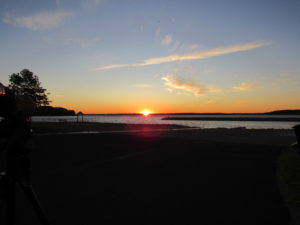
I woke up around 4:30 AM, and wondered why my alarm was going off. As I drifted back to sleep,
I suddenly realized why – I had a birding expedition! I was supposed to be there at 6:30 AM, and it
was over an hour and a half away, not including the time it takes me to get my lunch packed, etc.
One slow van in front of me put me as the last of 16 birders to arrive at the McDonald’s in Carlyle,
our meeting place. I then carpooled onward with Craig Taylor and Kimberly Rohling, until our
entire group stopped near the entrance to Eldon Hazlet State Park.
Pulling off at the entrance area, warblers proved to be abundant, if fleeting. Thankfully, a half-
dozen Black-throated Green Warblers decided to take pity on the photographers in the group, and
showed themselves well as they bounced around the top of a planted Bald cypress tree.
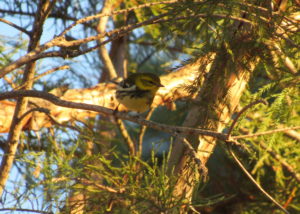
Black-throated Green Warblers (Setophaga virens) are a favorite of mine, mostly because they’re easily recognized. Few other birds have such a bright yellow head combined with dark stripes
underneath. We moved on from these, picking up several more species along the way. I had my
first miss of the day with Blackburnian Warbler, when Colin saw one well enough to get a photo.
That would’ve been a lifer if I’d seen it.
We moved to a spot where someone spotted a would-be Le Conte’s Sparrow in the brush, and all
but myself and two birders went down to look for it. The three of us continued talking and
mentioned that we’d love to find a Nelson’s Sparrow. I spotted what I thought was the Le Conte’s
Sparrow in the bush and took a record photo (what I call photos where the bird isn’t easy to find
or particularly well-photographed). Curiosity got the better of me, and I went down to see what
was so fascinating. Keith McMullen mentioned that they’d found a Nelson’s Sparrow. I double-
checked my photo of the “Le Conte’s Sparrow”- it’s a lifer Nelson’s. With this Nelson’s Sparrow (Ammodramus nelsoni), I’ve seen all but one of the regularly-occurring sparrow species in Illinois. (That one exception is the Clay-colored Sparrow.) I was very happy with this very unexpected
find!
I laid on my back on the ground to look at a male Summer Tanager (Piranga rubra), arrayed in
fine red, the only completely red bird in the US. Unlike male Scarlet Tanagers, male Summer
Tanagers stay red all year long. They are currently expainding their range northwards, being a
Southeastern species. Formerly, they were on the edge of their range in central Illinois. Now,
however, they are found even as far north as Chicagoland. I got good looks, and despite being
directly underneath the bird, it chose not to poop on me. I wish gulls were so kind.
I strongly appreciate Eastern Wood-Pewees (Contopus virens) for their willingness to grant an excellent photo opportunity. These were the only flycatchers of the day, besides Eastern Phoebes. Evidently, the rest of the flycatchers have moved on.
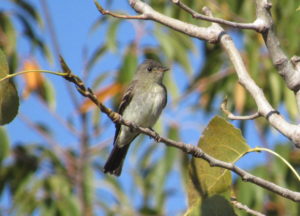
Another stop found me my second lifer of the day, a Philadelphia Vireo, the last of the commonly-occurring vireos for Illinois that I wanted to find. The second irritating miss of the day came when someone else found a Chestnut-sided Warbler and it got away before I could find it. Honestly, the whole day was someone finding a bird I could barely even see, and my glimpsing it just well enough for ID purposes before it flew away into the undergrowth. This was the case right up until the pelagic…
We spotted several more species, including ten species of warblers for me, a personal record for one morning. I was definitely the least-experienced birder on the trip, which is why I’ve elected myself to write it up. I believe the count was ~70 species seen by the group when we left Eldon Hazlet State Park, which is quite respectable for one morning! (I had 64 species.)
Hundreds, if not thousands, of Double-crested Cormorants (Phalacrocorax auritus) and American White Pelicans (Pelecanus erythrorhynchos) were present on Carlyle Lake that day. It’d been awhile since I’d seen so many American White Pelicans. There’s something so comical and yet so majestic about a flock of pelicans, and there’s certainly little else to match their size.
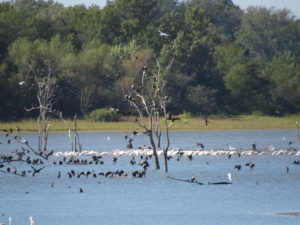
A Northern Parula (Setophaga americana) at Whitetail Access decided to demonstrate how to do the splits upside down and eat bugs off a leaf at the same time. Northern Parulas are a special bird for me – my first ever warbler was a dead Northern Parula at the base of the windows of a hospital in downtown Springfield. After that, I heard a few, but I didn’t see one in the wild until the one I saw at Eldon Hazlet State Park, and this one at Whitetail Access proved far more interesting to watch up close – well, about fifteen feet.
A Northern Harrier (Circus hudsonius), a Wilson’s Snipe, and an Eastern Screech-Owl (heard only) proved to be three of the four best finds at Whitetail Access, almost entirely devoid of birds on its mudflats. Shorebird season is wrapping up. Red-shouldered Hawks were spotted on the way here, and several were seen throughout the day.
The next great bird we found was a Marsh Wren (Cistothorus palustris), the last breeding species of wren I hadn’t found in Illinois until now. (We’re going to ignore Bewick’s Wren in this discussion, despite the possibility that they reside in far western Illinois still.) The Marsh Wren is half a lifer for me. I heard one singing in Indiana in August, but I never saw it, and it’s hard for me to really count a bird as a lifer until I see it. So, this is lifer 2.5 for the day. This little wren is very unusual. It creeped through the brush until being flushed into a nearby bush, where it scolded us from a partially-concealed perch. This behavior is unusual for someone used to Carolina and House Wrens, but isn’t uncommon for this species.
I prefer to look for shorebirds over songbirds. Sure, shorebirds are hard to tell apart, but much of the time they let you sit and try to figure it out! This one below is a Greater Yellowlegs (Tringa melanoleuca) at Patoka Access, where we stopped to find some shorebirds when Whitetail Access proved to be rather poor in that respect. My first Black-bellied Plover was spotted across the bay. A third lifer for the day!
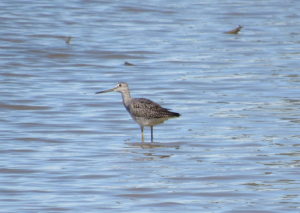
Alongside the Black-belled Plover, three American Golden-Plovers and several Sanderlings made for an interesting mix of shorebirds. I have never seen those three species together before. A few Cliff Swallows flew past, severely overdue to migrate south. They were quite early this year and have stayed equally late. I’m really not sure what they were doing there. Another good find I missed there was a Peregrine Falcon.
We boarded two rented pontoon boats to participate in the actual “pelagic” part of the trip. A pelagic in birding terms is a boat trip, usually out to the middle of an ocean or a big lake, after birds that only live on the open ocean (or large open inland water body, like Carlyle Lake, during migration). A Sabine’s Gull, one of those species that can only be found rarely on open bodies of water like this, had been seen the night before, but we all struck out on that one, the third big miss of the day. At least I saw Sabine’s Gull last year on Lake Springfield.
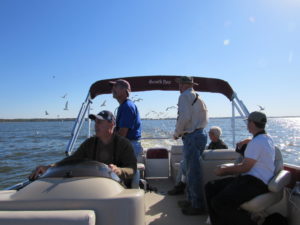
Throwing bread off the back of the boat to bring in any rare gulls, we only found three species – Ring-billed, Bonaparte’s, and two Herring Gulls. Still, as you can see, we had some of the best eyes in the state looking for it, in two boats. From left to right above, we had Tyler Funk, Keith Mcmullen, Craig Taylor, and Colin Dobson, all scanning for whatever we could find. Sitting on a boat for three hours or more, doing nothing but looking through what seems like an endless colony of Ring-billed Gulls (Larus delawarensis) is not for everybody. I enjoyed it, but the pelagic section was definitely much slower-paced than birding on the shoreline of Carlyle Lake. Pelagic trips are not for people who prefer instant results.
We did have the other boat to help spot birds. Occasionally the gulls would swarm us, and it was at this point that I’d wear my hat to keep the shower of gull crap from hitting me. Our pilot, Tyler Funk, spotted something in the water that the rest of us didn’t. In addition to steering the boat and looking for Sabine’s Gulls, he’d spotted this little guy on the water:
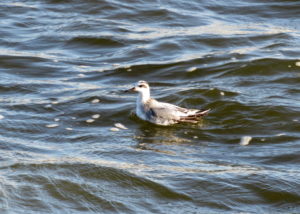
It was the fourth lifer for the day, (I’ll just say fifth by combining the “half-lifers” Northern Parula and Marsh Wren), a Red Phalarope (Phalaropus fulicarius). This was somewhat unexpected. Red Phalaropes, despite their small size, almost entirely live far out at sea, only flying up to the tundra in far northern Canada to breed. These are the rarest of the three phalaropes in Illinois (all three of which are the only phalaropes in the world, which means I’ve seen all of the phalaropes in the world). This Red Phalarope was incredibly tame, allowing for close approaches.
It got within about eight feet of the boat, and if there had been no waves and a better cameraman behind the camera I’m sure my pictures would be better. As it was, I’m still impressed with how well we saw this bird. It even called and did a little feeding as we watched, the black and white pattern helping to hide it surprisingly well in the waves once it flew further away. We caught up to it again, and took even more photos. This bird is rusty-red in the spring. It’s in fall plumage currently. I saw a similar looking bird once, the Red-necked Phalarope, which has a similar life cycle and can look quite similar. However, that bird has a dark, striped back and a thinner bill and body shape.
We let the Phalarope go back to its merry spinning (They spin in a circle to concentrate plankton in the water, and then eat the concentrated plankton.), while we paid attention to the nearby tern flocks. Forster’s Terns (Sterna forsteri) congregated in large numbers off to the east- I’ve never seen anything like it! We saw not a single other species in the flocks of hundreds of birds (the other boat did see a lone Black Tern some time before this, but we didn’t). We watched them fly off as we made our way back to the boat docks, to end the day.
With 89 species, I did pretty well. That may or may not be the greatest number of bird species I’ve seen in one day, though I’d have to double-check. Either way, I strongly enjoyed meeting all the birders and I couldn’t have asked for more lifers! There were three subjects of discussion that dinner – southern Arizona dream trips, birding stories, and horseshoes – that last, the famous Springfieldian “burger” with Texas toast, fries, and cheese sauce. We all split up around 8:00 PM, to get back to our usual lives. And thus concluded my first “pelagic” trip.
Thanks to Craig Taylor for driving me and Kim Rohling around all day, Tyler Funk for finding the best bird of the day in the Red Phalarope, for steering my boat, and for organizing the trip, and to Keith Mcmullen. It was wonderful to meet a few of my longtime readers, and even better to met those whose eBird checklists I’d read in the past with considerable envy. I’m already planning to return next year- we’ll have to see what happens then!
Text and photos by Jared Gorrell
